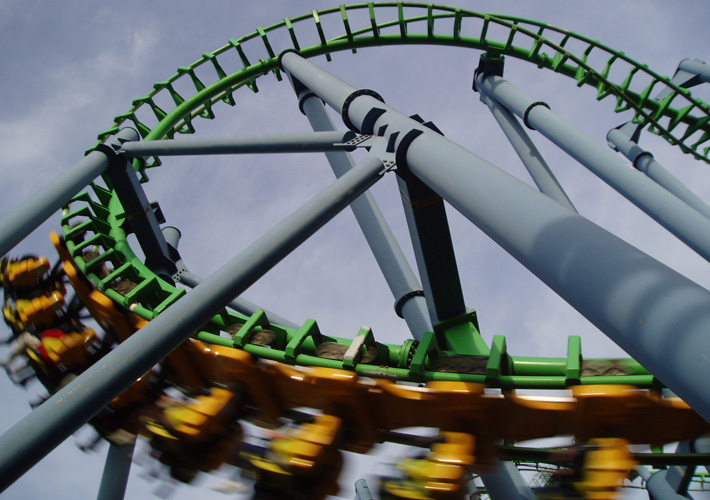
How Roller Coasters Are Using Technology to Reach New Heights – Podcast
Amusement rides are entering the “EST” economy: tallest, fastest, highest, biggest. That’s according to amusement ride expert Franceen Gonzales, who spoke on the latest episode of ASTM International’s podcast, Standards Impact.
During the interview, host David Walsh spoke to Gonzales, chief experience officer of WhiteWater West Industries, and Jim Seay, owner of Premier Rides. Both industry professionals and members of ASTM's committee on amusement rides and devices (F24), the pair spoke about how amusement parks are pushing thrills to new heights and the way standards are framing safety as a priority. During the conversation, they shared a wealth of insights about exciting technological innovations, how the amusement ride industry is exploding across the globe, and the role of standards in driving the industry forward.
Read an excerpt of the episode below or listen to the episode here.
David Walsh: Where is the field of amusements and attractions headed, and what types of rides are we going to see in the future? I think a lot of us can't imagine much more than that wooden roller coaster that used to go up and down.
Jim Seay: Well, they're going a long way away from that wooden coaster. Although you'll see some great new wooden coasters coming out that used very advanced technologies. If you looked at a new wood coaster, you wouldn't realize they have advanced non-contact magnetic braking. That's the same type of braking that's used on aircraft carriers to stop planes when they land. It actually comes from our industry and has been applied into a military environment. We are a hub for innovation. My background is aerospace engineering, and my focus now is on these high tech rides. We don't think in the sense of limits when it comes to creativity; we think in the sense of limits when it comes to standards that are being applied to ensure safe design.
LISTEN: Following Asbestos Ban, What Is Next for Workers and Families?
When you look at the rides coming out today, they're faster, they're more dynamic, they're taller, and they will continue to go in that direction. If you traveled in the last month, you're traveling up in a plane at 35,000 feet. These days, everybody keeps their windows closed. They're not even impressed being up that high anymore. The idea of rides going to 400 feet, 500 feet, and higher is certainly possible. Layered on top of that, what I see is this opportunity to make experiences very immersive as well, whether it's through intellectual property layering or just new types of products where people can be more interactive with the experience itself. We just opened a Guinness World Record attraction down in the Middle East, and on top of it was incredible audiovisual projection mapping experience that took what is just a coaster to really the next level, made it a themed attraction. And I see a lot of that coming up in the future.
Walsh: If you could cite one trend in the industry right now, the hottest trend in rollercoasters specifically, what would you say it is? When I was younger, it was the ability to go in a loop-to-loop, upside down. That was amazing 40 years ago. But what would you say is the one trend now?
Seay: There is still a big push on height. We’re working on record height attractions. The one I mentioned in the Middle East was a record height attraction. What is different now than when you were going on those rides back then, there's a great ability because of all the magnetic launch systems. What you find on that same aircraft carrier, the way the planes take off now, there's no steam catapult system. There's a magnetic launch system that launches the planes off. We use those same systems now, and they allow you to provide high thrill attractions. Even if somebody is underneath an airport and can't go up high, we can, we can still give you a hundred-mile-an-hour experience easily without having to go 300 feet up in the air. So it's not just height, it's really that combination of those tools that allow these thrilling experiences.
Franceen Gonzales: What I'm finding is that we are in the EST economy. It's tallest, fastest, highest. It's biggest. Certain parts of the industry are really centered around that. Now, I think it's a little bit tough. Jim said it right. You don't have to be the tallest to be the most thrilling, and you don't have to be the highest. Somebody tomorrow's is going to be one meter higher. So how do you create these really amazing experiences? We've just did the water slide tower. It's kind of a first in the world, in Doha, Qatar, and it is 83 meters tall. It's got 12 water slides built around it. It's got an elevator system in the middle, and it is built on a manmade island to look like an oil derrick. It is incredible.
NEVER MISS AN EPISODE: Follow Standards Impact on Spotify
When you really look at this structure, you think about what has gone into the structural engineering, what has gone into the ride path engineering, and what's gone into the aesthetic engineering. So looking at it and saying, “Does this look beautiful?” What I would say that what we're seeing is an evolution of the technology where you have to be able to build big and build safe. At the same time, there are a lot of people that like to say, “I can build that,” and really they can't. It’s really about making sure that the people that are engineering these have the right tools and have the right standards. ∎
 SN Home
SN Home Archive
Archive Advertisers
Advertisers Masthead
Masthead RateCard
RateCard Subscribe
Subscribe Email Editor
Email Editor